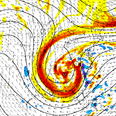-
Posts
5,750 -
Joined
-
Last visited
Content Type
Profiles
Blogs
Forums
American Weather
Media Demo
Store
Gallery
Everything posted by brooklynwx99
-
honestly that's just not going to happen later in the winter but it would be funny if it happened in December just to see the rage. i can see that happening in Dec
-
some LR OP ragebait on a fine Thursday afternoon
- 1,295 replies
-
- 5
-

-

-
- wishcasting
- almost winter
-
(and 1 more)
Tagged with:
-
just going to post some LR OP ragebait
-
so I've learned from many of the proponents of a strong-super canonical EP event that a one month VP mean isn't great because it doesn't take variability into account, but that a multi-month VP mean isn't good either because it smooths MJO pulses out so which one is it? might as well throw tropical forcing out the window as if it isn't one of the most important mechanisms for our weather lmao
-
it's of similar strength to years like 2002 and 2009 when looking at Aug-Oct means. what's nice is that even accounting for month-to-month variability, this event just pales in comparison to the past Super Ninos and is much farther west
-
this is what i mean when I said that there isn't convincing anyone at this point. there's nothing you can show to get people off the canonical super Nino bandwagon if they're already on it. sunk cost fallacy i guess
-
I agree that one single month might not tell the whole story, but this event has behaved differently in that department for pretty much the entire late summer and fall. it isn't just one month. the differences over South America are especially glaring
-
so triggered lmao
-
nothing says “strongly coupled” like interfering factors that have mostly flipped
-
@griteater would have something to say about the polar regions looking unfavorable I am seeing more evidence for blocking than not. moderate to strong +ENSO events favor blocking. then factor in the -QBO and solar and it's pretty heavily favored to see periods of blocking this winter
-
ENSO is a bigger factor than the PDO. there are times where ENSO and the PDO are out of phase, and this year seems like a good candidate. the PDO can positively or negatively feed back on the PNA... a La Nina and -PDO will positively feed back and produce a persistent -PNA and vice versa. the -PDO likely negatively feeds back on El Nino this year, but +PNA is still favored overall also what's occurring now doesn't have much bearing on the winter. November 2009 had the TPV sitting over AK
-
yeah this isn't a scenario where a good December means that the Nino isn't taking hold... most Ninos that start well also end well. 2002 and 2009 are good examples
-
not that i know of, but 200mb and 500mb are correlated well enough that it would pretty much look the same
-
looks great to me. but Pac puke!!!!!
-
this is conveniently left out for some reason. I was told by someone that the forcing can't be used month to month because of sub-monthly variability lmao there is no convincing anyone of these differences at this point
-
no, no, this is obviously a classical, canonical, and even prototypical EP super Nino that is going to behave completely normally
-
also, given that the -PDO may be messing with the MEI, the RONI is still about half a degree weaker than the ONI, and it's simpler and doesn't take as much into account. this event still isn't really acting like it should and that's ignoring the western lean to the forcing that we've seen for months. not sure why that's being conveniently ignored by a lot of people
-
i ask what he's talking about but he probably can't post again today. lmao
-
if this is "flooding the US with Pacific air," i have a bridge to sell you. what are you even talking about? the Aleutian low is backed way west
-
Raindance is above such silly indices as the RONI and MEI. we are just plebeians compared to his vast sea of atmospheric knowledge
-
PAUL ROUNDY SUPER NINO
-
it could be the IOD. not sure what else would do it 1986-87 did the same sort of thing. it also came after 3 consecutive cold ENSO events
-
oh man. I'm still expecting the Nino to couple... not really worried there but the "MEI is bullshit and you're just a weenie if you don't think this is going to act like 1997" stuff is so dated. no way this acts like its full ONI strength
-
2009 is a pretty good analog regardless
-
again, I don't understand the issue of the SW trough for December. most stronger Ninos feature this -PNA/+NAO pattern, so it should not be surprising. it is likely going to be a warm month





